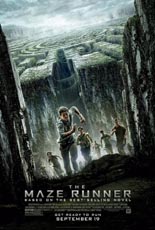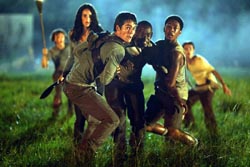
 Hungering for more teenage post-apocalyptic games? The Maze Runner is one of the best of that crop, while still visibly suffering from the core problems plaguing all the others: undercooked narrative, overelongated time and an overall feeling of genericness and déjà vu. Directed by newcomer Wes Ball, the blockbuster is based on James Dashner’s novel — the first in a series, of course!
Hungering for more teenage post-apocalyptic games? The Maze Runner is one of the best of that crop, while still visibly suffering from the core problems plaguing all the others: undercooked narrative, overelongated time and an overall feeling of genericness and déjà vu. Directed by newcomer Wes Ball, the blockbuster is based on James Dashner’s novel — the first in a series, of course!
Our protagonist (Dylan O’Brien, The Internship) is … well, he doesn’t even remember his name at the film’s start, when he awakens in an industrial elevator racing up from an underground who-knows-what and into a primitive village of several dozen boys who once were in his position. Once a month, out pop fresh supplies and new blood. Deep into the second act, the makeshift community gets its first and only female (Kaya Scodelario, Moon) and the movie doesn’t even broach the subject of what really would happen to the poor girl.
 They live in harmony — or at least compared to Lord of the Flies — captive and surrounded on all four sides by insurmountable walls that, on clockwork occasion, widen to a gap to reveal a labyrinth. At great risk to their lives, those tasked with entering have one goal: Find an exit.
They live in harmony — or at least compared to Lord of the Flies — captive and surrounded on all four sides by insurmountable walls that, on clockwork occasion, widen to a gap to reveal a labyrinth. At great risk to their lives, those tasked with entering have one goal: Find an exit.
See, this towering, ever-changing maze is populated with grievers. No, not widows sobbing over the death of their spouse, but giant robot spiders. (And that brings up a pet peeve I have with these kind of movies: What’s with all the needless vocabulary changes, invented lingo and only-us language? Why can’t it suffice for giant robot spiders to be called that? It’d cut down on the movie’s need to explain things.) Watching Thomas — that’s our hero’s name, once he hits his head hard enough to recall it — and his fellow runners maneuver the maze’s dangers is like watching a live-action adaptation of the board game Mouse Trap, or at least a YA variant on 1997’s Cube, but less fulfilling. —Rod Lott
